Garlic, otherwise known as Allium sativum is a member of the onion genus, Allium. Its relatives include the onion, leek, shallot, and chive. Garlic originally derives from Central Asia, specifically northeastern Iran.
The garlic plant has been associated as a seasoning herb for thousands of years, most notably in Ancient Egypt. People in ancient times also used garlic for medicinal purposes as well as for culinary preferences.
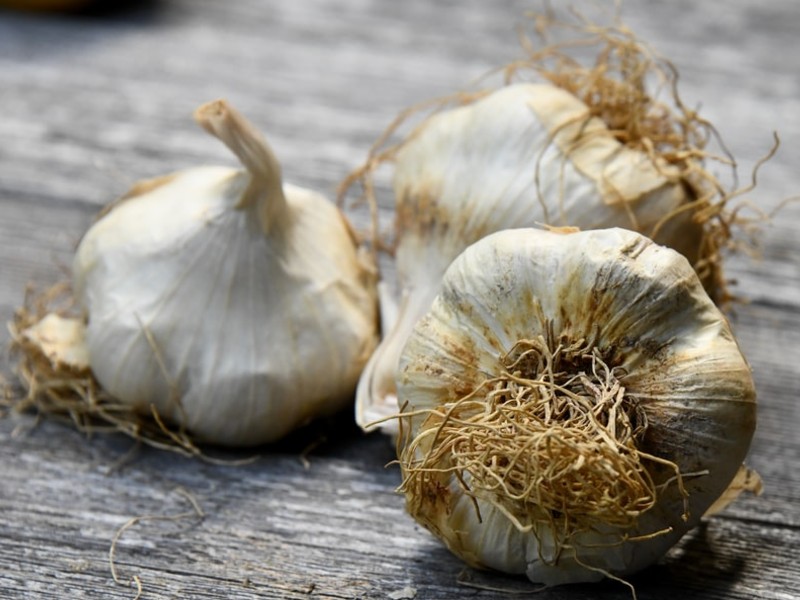
Today, garlic is widely used around the world as a zesty seasonal flavor, as well as being associated with many health benefits. Growing your own garlic is also very achievable, even if you don’t have the greenest of fingers.
This article will guide you through the process of growing your own healthy garlic bulbs at home, and providing you with everything you need to know about this versatile, little plant.
Different Types of Garlic Plants
Although there are over 450 identified strains of garlic, there are only two basic types of garlic plants.
These two different types of garlic include softneck (Allium sativum) and hardneck (Allium ophioscorodon) which are also commonly referred to as stiffneck.

Softneck Garlic Plant
Softneck garlic plants are best grown in milder climates. Softnecks don’t produce a scape (stem) and contain several small cloves per bulb.
From the softneck garlic plant, we get two common variations – artichoke and silverskin. Artichokes are named after the artichoke vegetable because of their similar appearances, and there are various different types.
Artichoke garlic plants are off-white in color with a thick outer layer that can be difficult to peel off. Artichoke has an appealing quality for gardeners because of its eight-month shelf life.
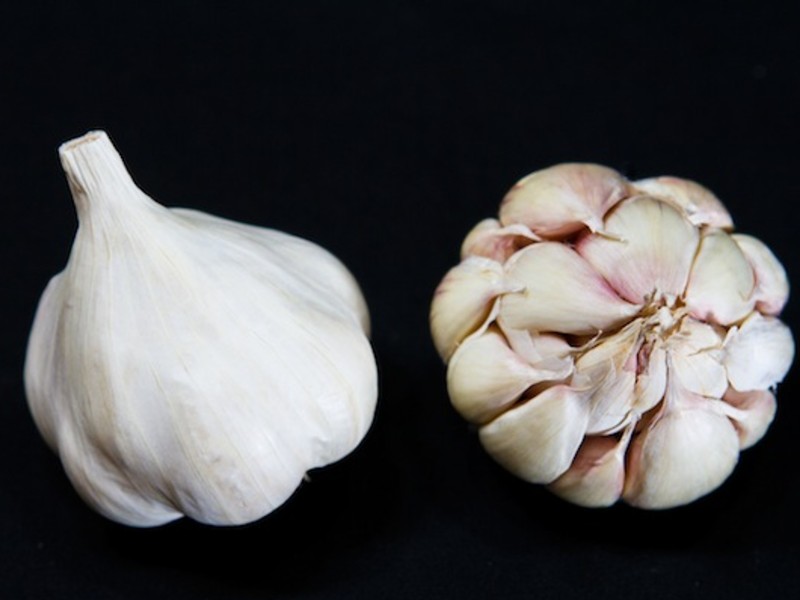
Artichoke Garlic Plants
- Applegate
- California Early
- California Late
- Polish Red
- Red Toch
- Early Red Italian
- Galiano
- Italian Purple
- Lorz Italian
- Italian Late
The second softneck garlic plant is silverskins, which grow in large quantities and are resilient to many different climates.
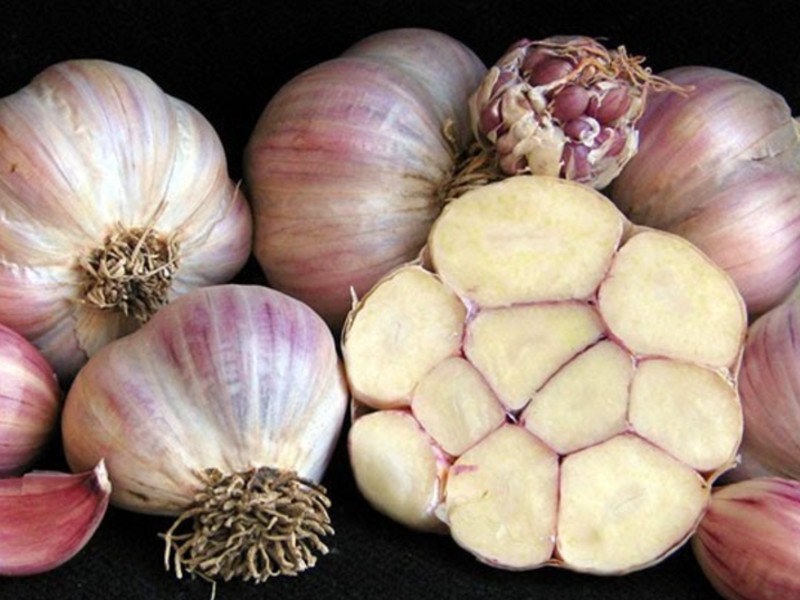
Silverskin Garlic Plants
- Polish White
- Chet’s Italian Red
- Kettle River Giant
Hardneck Garlic Plant
Harneck garlic plants contain fewer, larger cloves per bulb, and produce a scape (stem) that becomes solid, giving it a woody quality.
Hardneck garlic plants are related to wild garlic plants and have an array of complex flavors. The most well-known hardneck garlic is rocambole.

Types of Harneck Garlic Plants
- Chesnok Red
- German White
- Polish Hardneck
- Persian Star
- Purple Stripe
- Porcelain
- Yugoslavian
- French Rocambole.
- Northern Quebec.
- Rasa Blanca.
Some farmers and gardeners tend to categorize elephant garlic as a third type of garlic plant. However, this plant variation is more closely related to the leek.

Elephant garlic plants are distinguished by their huge cloves, similar to the size of a regular garlic bulb. In addition, they also produce a milder flavor and have an impressive garlic plant height of five feet tall.
Different Species of Garlic Plants
| Species | Commonly Known As | ||
| Allium sativum | Softneck garlic | ||
| Allium ophioscorodon | Hardgeck garlic | ||
| Allium ursinum | Wild Garlic | ||
| Allium oleraceum | Field garlic | ||
| Allium canadense | Meadow garlic |
Health Benefits of Garlic Plants
Garlic has been used in traditional medicine and home remedies for more than four millennia. With modern testing, we are able to confirm that garlic holds many health benefiting properties.
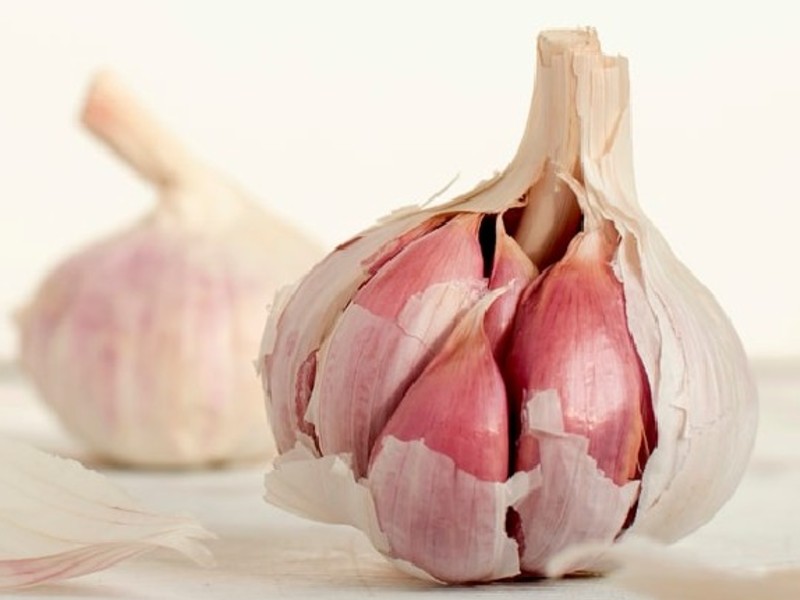
Nutritional Ingredients in Garlic Plants
- Manganese
- Vitamin B6
- Vitamin C
- Vitamin B1
- Iron
- Calcium
- Selenium
- Potassium
- Phosphorus
- Fiber
- Amino acids
- Antioxidants such as Allyl Cysteine, Alliin, Allicin, and Allyl Disulfide
What Can Garlic Help Treat?
Find the different garlic species and their health benefits here:
Allium sativum: Known as softneck garlic, this contains phytonutrients, minerals, vitamins, and antioxidants that protect against coronary artery diseases, infections, and cancers.
Allium ophioscorodon: Referred to as hardneck garlic, this plant contains organosulfur compounds that are known to kill bacteria on contact.
Allium ursinum: Known as wild garlic, this particular garlic plant alleviates intestinal problems and respiratory issues. It also flushes toxins from the body and improves skin conditions.
Allium oleraceum: Known as the field garlic, Allium oleraceum helps reduce cholesterol and acts as a tonic for the digestive system.
Allium canadense: Also known as meadow garlic, this plant contains antiasthmatic, carminative, cathartic, diuretic, and expectorant properties.
Garlic Plant Facts and Information
As mentioned before, there are hundreds of identified garlic plants all over the world. However, experts have managed to narrow the list down to two distinct classifications of garlic, softnecks and hardnecks. Let’s take a look at their facts and information.

Softneck Garlic Plant Nutritional Facts
| Classification | Softneck garlic plant | ||||||
| Scientific Name | Allium sativum | ||||||
| Taste | Strong and pungent | ||||||
| Major Nutrients | Vitamin B6 (8.54%) Manganese (6.52%) Vitamin C (3.11%) Copper (3.00%) Selenium (2.36%) | ||||||
| Health Benefits | Treats urinary tract infections Rich in antioxidant activity Eliminates contaminants Prevents the buildup of plaque Reduces blood pressure | ||||||
| Calories | 13 Kcal in 3 cloves |
Hardneck Garlic Plant Nutirtional Facts
| Classification | Hardneck garlic plant | |
| Scientific Name | Allium ophioscorodon | |
| Taste | Rich in spice and more ‘garlicky’ | |
| Major Nutrients | 0.2 grams of protein 0.1 grams of fat 05 grams of fiber 1.0 grams of carbohydrates 1.4 mg of calcium 10 mg of phosphorous .07 mg of iron 0.9 mg of sodium 26 mg of potassium .01 mg of vitamin B1 .004 mg of vitamin B2 .02 mg of niacin .75 mg of vitamin C | |
| Health Benefits | Helps treat acne Contains anti-asthmatic properties Reduces high blood pressure Lowers elevated cholesterol Eases allergies | |
| Calories | 2-7 Calories |
Garlic Planting Season
Garlic planting season consists of planting in the fall and harvesting during midsummer. Planting garlic in the fall or early winter allows the plant to develop strong roots before the ground freezes.
However, be careful not to plant garlic bulbs too early as this may encourage the top of the garlic plant to grow before freezing temperatures set in. Of course, garlic planting season may vary depending on a country’s climate.
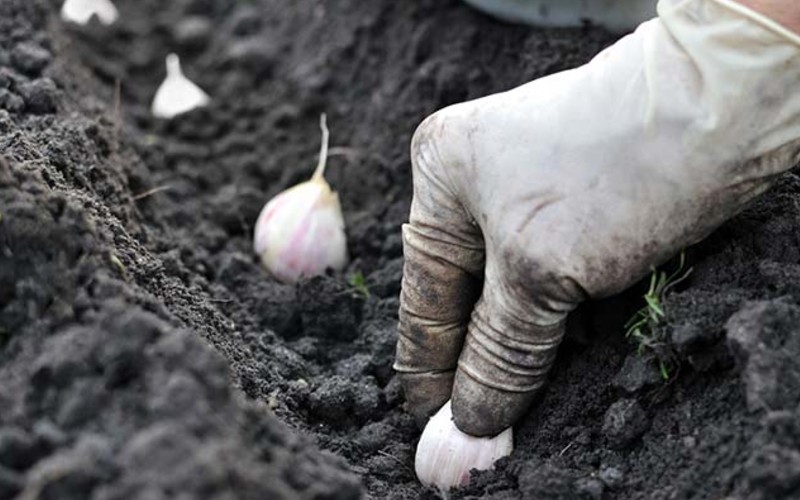
Garlic performs best when planted in a well-lit area and well-drained soil with a pH of 6.0-67.0. Adding compost or a raised bed also supports drainage in sites where there is heavy soil.
It’s important to remember that heavy, soaked soil that lacks drainage can lead to poor bulb formation and even disease.
Furthermore, garlic requires a large amount of feed. This means preparing the soil in the fall by adding compost or a slow-release nitrogen fertilizer.
In spring, switch from a slow-release source of nitrogen to a fast-release nitrogen, when shoots are six inches tall.
How to Plant Garlic
There are three essential ways in which you can plant and grow garlic. No matter which process you choose to propagate and grow garlic, you need to keep in mind the right soil, planting site, temperature, and climate.
Planting Garlic Cloves
Fall is the ideal season for planting garlic cloves. Although in countries with longer growing seasons and warmer climates, garlic can be planted in the late winter.
Garlic plant spacing is key in promoting a successful garlic propagation. Place each individual clove six inches apart in rows of 24 inches, allowing for three to four rows per bed. Separating each bulb is important as one single bulb can yield up to eight garlic plants.
Garlic planting depth is also an important factor to remember when planting garlic. The correct measurement of soil covering the garlic clove prevents it from growing above the ground during freezing weather conditions.

In order to achieve this, press the clove two to three inches down into the soil with the pointed top upright, or place in a furrow and cover with soil.
Add an additional four-inch layer of mulch or compost on top of the soil in order to allow for correct garlic propagation.
In the springtime, maintaining the soil’s moisture is crucial for the development of the garlic plant. Make sure to monitor the moisture level regularly and water as necessary.
Planting Garlic Seeds
Growing garlic from seeds is a lot more difficult and complex than planting and propagating garlic bulbs. This is due to the longer amount of time it takes to grow garlic from seeds in comparison to garlic cloves or bulbils.
Garlic seeds are contained in the mature, dried flowers of the garlic plant and are small in size.

When planting the garlic seeds, make sure to plant indoors in the fall by using a high-quality starting mixture. Cover with a quarter-inch of soil and keep in an area of 65 degrees Fahrenheit (15 C.).
It is important to keep the seeds covered so that they retain both moisture and heat. Make sure to keep them in a well-lit area when the seeds begin to emerge from the soil.
Planting Garlic Bulbils
The third method of planting garlic is by planting garlic bulbils, also known as a garlic flower. Located in the scape of hardnecks and softnecks, bulbils are small bulbs that function as seeds when planted.
Planting garlic bulbils have the advantage of growing at a faster rate in comparison to propagating garlic cloves and seeds.

Start by planting the garlic bulbils during the fall, one inch deep in the soil. When the spring comes around, be wary not to weed out the seedlings that emerge. These seedlings are often mistaken for grass because of their similar resemblance.
Leave the garlic plants in the ground until the tops of the scapes turn brown. This is a key indicator of when to start harvesting.
It’s important to note that planting garlic bulbils may result in much smaller sized bulbs in comparison to planting and propagating garlic from cloves.
How To Propagate Garlic
Achieving a successful garlic propagation goes hand in hand with how you plant garlic.
Propagating garlic plants requires cultivated beds filled with compost in order to enhance the soil and encourage draining.

Following the correct planting depth and spacing will also guide you in managing a rewarding garlic plant propagation.
It’s also important to keep in mind what climate you’re planting garlic in. For example, softneck garlic plants flourish best in warm climates, while hardneck varieties are more suited to cooler climates.
Growing Healthy Garlic Plants
Garlic plants can be susceptible to a variety of diseases if not maintained correctly. These include:
- Vegetable rot due to penicillium fungus
- Mucor fungus
- White rot
- Fusarium bulb rot
- Embellisia skin blotch
- Botrytis neck rot

To prevent these diseases, there are a few practices you must be consistent with in order to promote a healthy garlic propagation.
In order to practice good garlic plant care and healthy garlic propagation, keep the planting area free of weeds. Pressure form weeds can reduce a bulb’s size by a substantial 30%.
Only plant seed-stock quality garlic. Exercise a three to five-year crop rotation, and maintain good drainage. It’s also crucial to examine, inspect, and observe your crops on a regular basis.
Curled stalks or scapes that remain one to two months after the first appearance of leaves must be clipped or “topped” by cutting the scape from the plant when it begins to curl.
Topping promotes healthy growth and encourages the plant’s energy to focus on growing the bulb as opposed to the scape.
Harvesting Garlic Plants
Knowing how to harvest garlic plants all boils down to knowing when to harvest.
The best time to harvest is in the summer when the bottom leaves begin to turn yellow and the lower leaves become brown.
It’s vital that you don’t leave the bulbs in the ground too long as this will cause the bulb to rot.
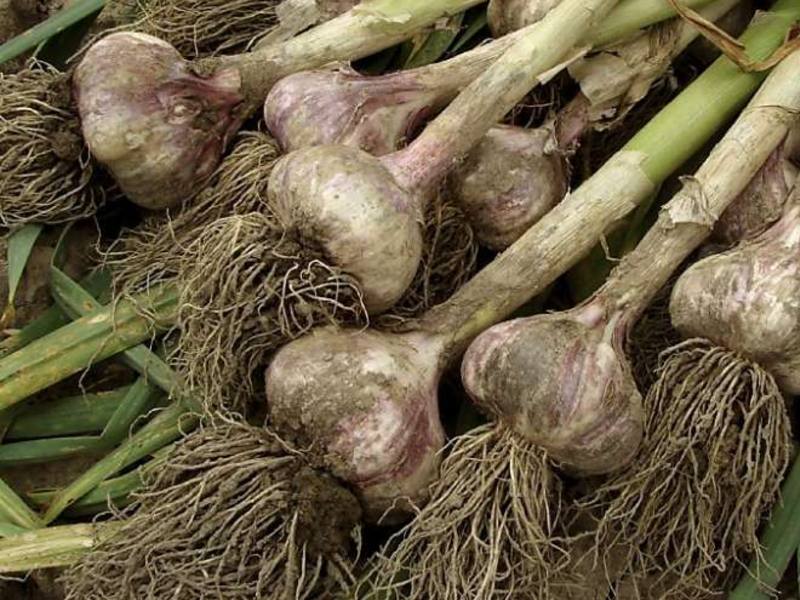
Use a spading fork to remove the bulb from the soil and brush off any dust and soil before storing the garlic bulbs.
Following the harvest, the next step is curing. This is the process of partially drying the garlic plant by braiding or tieing the garlic scapes together and hanging them. This is especially important in preventing decay.
Tie the stalks of the garlic plants together with string in bundles of five to ten. Hang in a warm, shaded location with breathable air circulation. Make sure to avoid direct sunlight and intense heat during this process.

The action of curing may take two to three weeks to complete. Wait for the bulb to form several layers of papery skin, and the stalks to turn brown before cleaning and storing the garlic.
Finally, keep the bulbs in a dry, cool, well-ventilated area, and enjoy!
How to Grow Garlic Sprouts in Water
There is a misconception that garlic plants can only be grown in the ground, outdoors. However, this is not the case.
Growing garlic in water is a quick and easy way of accumulating fresh garlic in the comfort of your own kitchen.
It’s important to note that growing garlic in water doesn’t mean you will produce the actual clove itself. Instead, you will be capable of growing the green garlic plant leaves, also known as garlic sprouts.
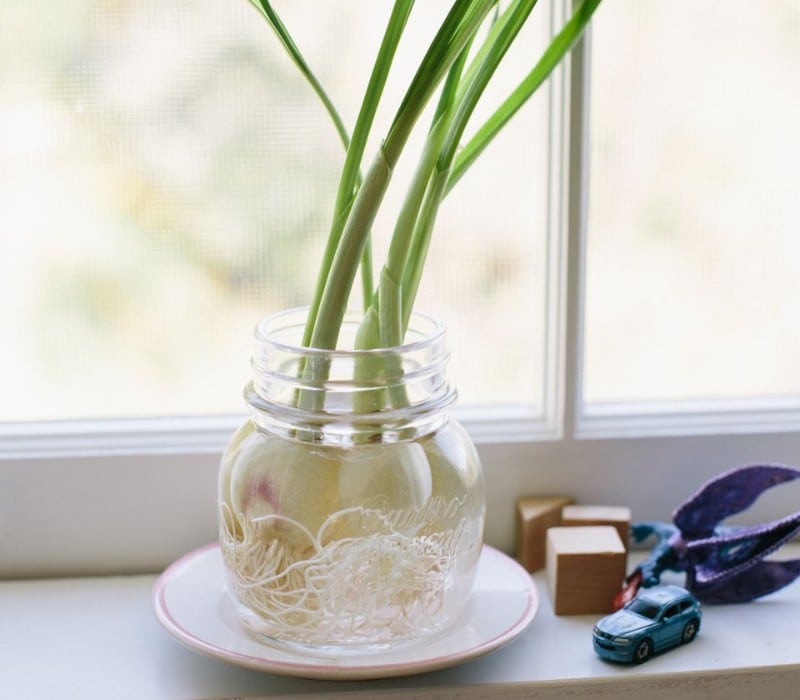
These sprouts grow vertically from the garlic clove once placed in water for a certain period of time.
Follow this step by step guide below on how to grow garlic sprouts in water.
1. Place Sprouted Garlic Cloves in a Glass
Take one or more garlic cloves that have already begun to grow green sprouts, and place them in a clear glass or jar.
Situate the garlic cloves so that the sprout is pointing upwards. Pour enough water so that the bottom of the garlic cloves are covered.
Use only lukewarm water and be careful not to completely submerge the garlic cloves, otherwise, they will rot.

2. Leave the Glass in a Sunlit Area
Place the jar in a well-lit area, preferably a windowsill for 4-7 days. If the tips of the garlic sprouts begin to turn brown or wilt, remove the jar out of the sunlight for 1-2 days.

3. Keep the Water Fresh
If the water becomes cloudy and murky, replace it with fresh water. This will ensure a healthy dose of water for the growing garlic. Make sure not to over-fill the jar with water.
It’s important to note that you may only need to change the water once or twice before harvesting the garlic.

4. Ready to Harvest
The garlic sprouts will be ready for harvesting once they grow at least three inches tall. When the sprouts are between three and seven inches, you can remove them from the jar and cut off the tops.
If you leave the garlic sprouts to harvest after seven inches, they will leave a bitter and unpleasant taste.

Frequently Asked Question on Garlic
Since we get a lot of questions from our readers regarding the garlic planting process, we’ve assembled a table of frequently asked questions below with detailed answers.
What is the difference between a garlic bulb and a garlic clove?
A garlic bulb, also known as the head of garlic is the section of a garlic plant that grows beneath the soil and houses several garlic cloves within it.
A garlic clove lives within the garlic bulb along with several other cloves. When planting a single garlic clove, it has the potential to become a clone of its parent garlic bulb.
Can you grow garlic from a clove?
Yes. In fact, each garlic clove can grow into a fully grown garlic bulb after about nine months, when planted, maintained, and harvested properly.
How long for a garlic bulbil to grow into a garlic bulb?
Depending on the variety and type of garlic plant, bulbils can take two to three years to grow into a garlic bulb.
If a bulbil is planted in the fall, it will become a single garlic clove by the summer. It then takes an additional year to evolve into a small garlic bulb with its own individual garlic cloves.
The size of the garlic bulb depends on the quality and maintenance of the soil, fertility, pH balance, climate, growing conditions, and of course the type of garlic plant.
Can I grow garlic indoors?
Yes, growing garlic indoors is possible. However, you may not be able to produce a head of garlic with the same quality as you would if you were to plant garlic cloves in the garden.
Instead, you will be able to produce garlic sprouts or greens. This is not to be mistaken for early spring garlic grown from immature garlic bulbs.
Nonetheless, the garlic sprouts are just as tasty as spring garlic, but lighter in flavor and have less of a pungent taste.
Start Growing Your Own Garlic Plants at Home
Growing garlic plants is definitely a manageable and achievable project to take on. With regular observation and maintenance, as well as knowing the right information, you can become your very own agriculture connoisseur with your own garlic farm.
Start growing your own garlic plants at home today and be the source of your own sustainable produce.

Leave a Reply